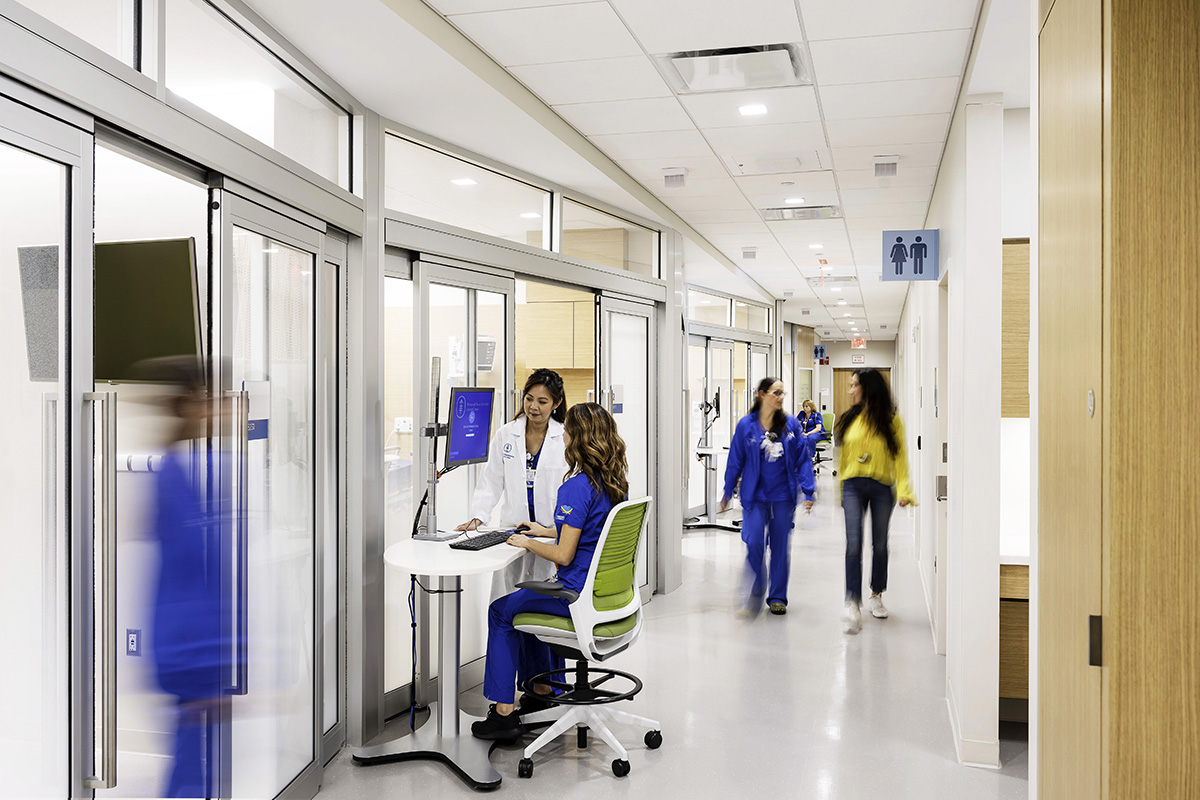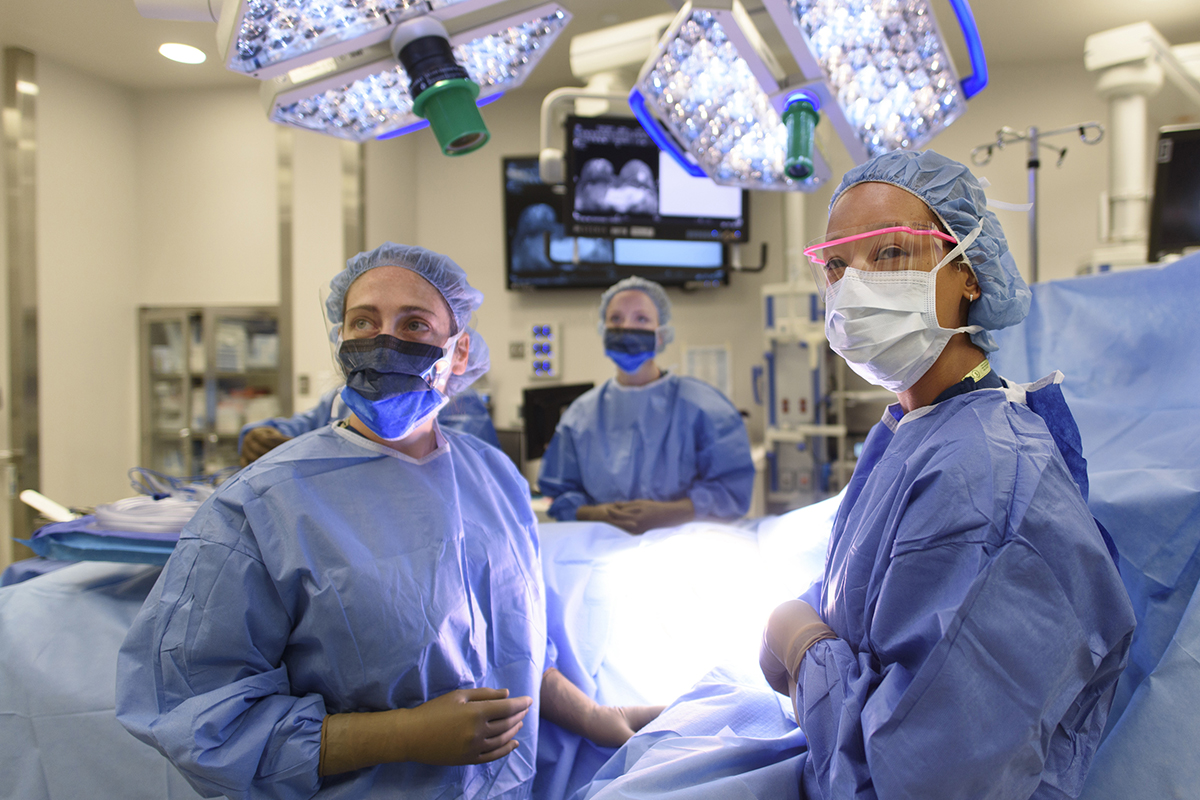
Raquel Bullard, a nurse in the post-anesthesia care unit (PACU) tends to a patient at the David H. Koch Center for Cancer Care.
If you are scheduled for a procedure, you will be taken care of by members of our anesthesiology service. The type of anesthesia you receive depends upon the nature of your procedure as well as coexisting medical conditions that you might have. An attending anesthesiologist will talk with you about which form of anesthesia is best for you and what to expect. In the meantime, here are answers to some common questions.
Questions You May Have About Anesthesia
What is anesthesia?
The term anesthesia is derived from ancient Greek and means “no sensation”. Medications will be administered that will alter your sensation or level of consciousness. General anesthesia is a state of unconsciousness, freedom from pain and amnesia induced by your anesthesia team, which is required for many types of surgery. Your breathing and circulation will be monitored continuously while under our care. Your safety and comfort are our utmost concern.
Who are members of your anesthesia care team?
Anesthesiology is the medical specialty focused on the care of patients before, during and immediately after a surgical or interventional procedure. A member from your anesthesia care team will always be with you adjusting the anesthetic to fit your individual needs.
-
Attending Anesthesiologist
- All of our anesthesiologists are board-certified, and many have received additional training in subspecialty areas (e.g. critical care, cardiothoracic, pediatrics).
- The attending anesthesiologist is the care team leader and responsible for your anesthetic.
-
Certified Registered Nurse Anesthetists (CRNA)
- CRNAs are advanced practice nurses who have undergone a rigorous graduate level educational program focusing on the administration of anesthesia.
-
Anesthesia House Staff
- These are physicians in the process of training (residency) to become anesthesiologists.
How does anesthesia work?
General anesthesia creates a state of unconsciousness, freedom from pain and amnesia induced and monitored by your anesthesia team. This is achieved using a variety of medicines that will be either injected into your circulation or inhaled into your lungs.
Regional and local anesthesia is achieved by using drugs called local anesthetics. These medications render loss of sensation by blocking the transmission of pain by your nerves. Local anesthesia blocks a small area by injecting it directly under the skin. Regional anesthesia is achieved by utilizing an ultrasound machine to guide a needle into a space around your nerves. Once correctly positioned the local anesthetic is injected with subsequent numbing of the entire regional supplied by the affected nerves. Anesthesiologists refer to this as a “nerve block.”
Epidural and spinal anesthesia are also forms of regional anesthesia. Local anesthetics are administered within the spine and block the transmission of nerves close to the spinal cord. Your attending anesthesiologist will discuss the risks and benefits of each technique in detail with you.
Sedation is a type of anesthesia that renders you relaxed and at ease, but not fully unconscious. This is done using IV medications. Sedation can range from light to deep, depending on the requirements of the procedure. Regional and local anesthesia is often supplemented with sedation. Your anesthesiologist will tell you what to expect before the procedure.
How long does anesthesia last?
Anesthesia medications are adjusted by your anesthesiology team to last as long as necessary for the procedure. After the end of the procedure you may feel groggy while your body eliminates the medications. Modern anesthetics are rapidly metabolized, which is why many patients are able to go home within an hour or two after ambulatory surgery. We recommend that you refrain from driving or making important decisions while you recover from the effects of your anesthetic. Patients who remain in the hospital or who take pain medications after surgery may experience drowsy effects from these medications, or from factors related to the surgery, but these are unrelated to the anesthetic.
Is anesthesia safe?
Modern anesthesia is extremely safe. While under anesthesia, your vital signs and depth of anesthesia are monitored closely by your anesthesia team. Most people, even those with serious medical conditions, can undergo anesthesia uneventfully. Your anesthesiology team will discuss specific issues related to your medical conditions and their effects on anesthesia.

Our facilities are designed with patient care and comfort in mind.
Presurgical Testing
Before your surgery, you’ll have an appointment for presurgical testing. This appointment may be in person or through a telemedicine visit, depending on your medical history and availability. During your presurgical testing appointment, you’ll meet with an advanced practice provider (nurse practitioner or physician assistant), supervised by an anesthesiologist (doctor who specializes in giving anesthesia). Your provider will review your medical and surgical history with you. Your care team may order other tests, such as a pregnancy test, an electrocardiogram (EKG) to check your heart rhythm, a chest x-ray, blood tests, and any other tests needed to plan your care. Some tests will be done at MSK, but most can be done elsewhere and sent to our clinic. Your advanced practice provider may also recommend that you see other healthcare providers. These tests and procedures will ensure that you have a safe experience and recovery.
If you are in the hospital before your surgery, an anesthesiologist will review your medical records, and you may speak with an anesthesiologist directly. Your anesthesia care plan will be explained to you before your surgery, as well as on the day of your surgery.
If you are scheduled for a minor interventional procedure you might bypass presurgical testing. You will meet with your anesthesiologist the day of your procedure.
There is information about anesthesia in the educational materials that your nurse will give to you or send to you in MSK MyChart (our patient portal) before your surgery. If you have questions about your anesthesia care after reading this page and the educational materials you’ve received, call 212-639-6840 and ask for the consulting anesthesiologist of the day.
On the Day of Your Anesthesia Procedure

In the operating room, your surgical team works together to ensure your safety and constant monitoring.
Preoperative Holding Area
On the day of your surgery, our staff will welcome you and bring you into the preoperative holding area. A nurse and patient care technician team will review your chart, take your belongings for safekeeping, and measure your vital signs (heart rate, blood pressure, temperature, and breathing rate) and oxygen level. You will meet your anesthesiologist and other members of your surgical team. You’ll have an additional opportunity to ask questions.
If your anesthesia care plan includes a nerve block, this will be performed in the preoperative holding area, with light sedative medications administered prior to the procedure. Information on nerve blocks is provided below.
In the Operating Room
Once in the operating room, you will be greeted by the surgical nurse, additional members of the surgical team, and your certified registered nurse anesthetist or anesthesia resident.
Anesthesia and medicines for pain control are carefully administered in a few ways to provide maximum effectiveness while minimizing any adverse effects. Our Anesthesiology Service uses evidence-based protocols, which, in addition to providing anesthesia safely, allows you to be awake faster, walk around early, have better pain control, and have less nausea (feeling like you’re going to throw up).
In addition to typical anesthesia medications, we may use nerve blocks, nonsteroidal anti-inflammatory drugs (NSAIDs), opioids, and other non-opioid medications to control your pain.
Recovering From Your Anesthesia Procedure
After your procedure, you will be brought to the Post-Anesthesia Care Unit (PACU). A PACU nurse, an advanced practice provider, and an anesthesiologist will be assigned to care for you as you wake up from anesthesia. We will give you medicine to control your pain. After a safe and comfortable recovery from anesthesia, you will be discharged from the PACU. Where you go next depends on the type of surgery you had, how long we expect you to be in the hospital, and how you are feeling. Your healthcare team will talk with you about this before your surgery.
Types of Anesthesia
Your anesthesiologist will determine the type of anesthesia care you receive based on your surgery and your medical history. Anesthesia can be provided as general anesthesia, regional anesthesia, local anesthesia or monitored anesthesia care (sedation).
General Anesthesia
General anesthesia will make you unconscious during your procedure. Your anesthesia care team will give you anesthesia that you will inhale (breathe in) and receive through an intravenous (IV) catheter. These will keep you asleep, pain free, safe, and comfortable. Your anesthesia team will monitor your vital signs throughout your surgery or procedure.
Regional Anesthesia
Regional anesthesia will cause numbness to a specific area of your body. We may give regional anesthesia in addition to or instead of general anesthesia.
- An epidural is a type of regional anesthesia for surgeries of your chest or abdomen. After giving a sedative, an anesthesiologist will place a tiny, flexible catheter that sits in the epidural space that surrounds your spine. A continuous infusion of numbing medication ensures that you feel no sensation in the site of your surgery. This can be done in addition to general anesthesia during your surgery or procedure. An epidural may remain in place for up to 7 days after your operation to control your pain.
- A nerve block is a type of regional anesthesia used for surgeries of limbs (arms or legs). After the anesthesiologist gives you a sedative, they use a small needle to inject local anesthetic around the nerves that supply sensory and motor function to the limb. This makes the limb numb for up to 8 hours, and makes you have much less pain right after surgery. With a nerve block, general anesthesia is often not required, but once in the operating room, sedative agents may be given to allow you to rest comfortably as your surgery or procedure is performed.
Monitored Anesthesia Care
- Monitored anesthesia care is sedation while under the continuous supervision of a member of your anesthesia care team. Sedation may be light, allowing you to be awake but sleepy during small procedures, or deep, allowing for short periods of what may feel like general anesthesia, where you’re not awake at all. The type of sedation you will receive will be explained to you in more detail by your anesthesiologist on the day of your procedure.
Enhanced Recovery After Surgery (ERAS®) Pathway
Our department uses the most up-to-date ERAS pathways for all cancer resection surgeries. These protocols ensure a streamlined perioperative experience that prioritizes early mobility, improved pain and nausea management, and better clinical outcomes. For more information, visit the Patient section of the ERAS website.